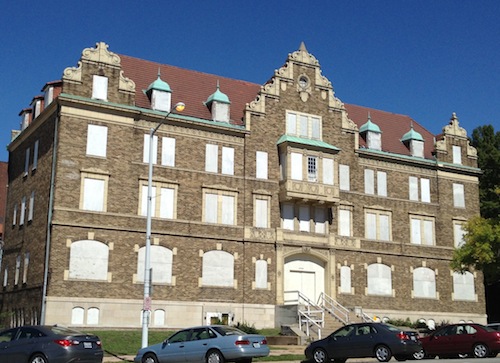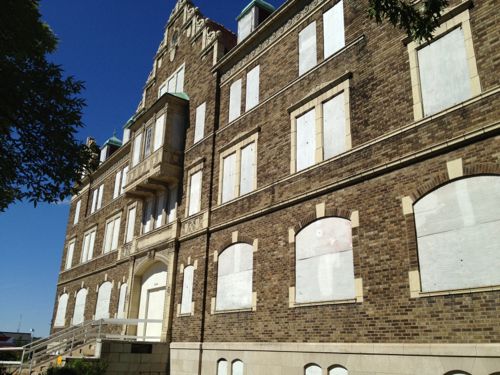The German House & A New Book On St. Louis Germans
For a while now I’ve been thinking about doing a post on the huge boarded building on Lafayette Ave but I didn’t have time to do the research. Then I received a review copy of Jim Merkel’s new book: ‘Beer, Brats, and Baseball: St. Louis Germans‘ and there among the many stories was the history of the building.

Jim Merkel sent me the text from that story from the book to use as a preview for you here:
The Place for Gemuetlichkeit
In the years before America fought the Nazis and Japan, Das Deutsche Haus was the place for all things Gemuetlichkeit. Opened in 1929 after a campaign that included help from such German luminaries as former mayor Henry W. Kiel, it soon became the center of German-American life here. The four-story brick building at 2345 Lafayette Avenue was the home of seventy-six German societies within three years after it opened. Built for $380,000, it had meeting rooms and halls able to accommodate crowds from 40 to 1,200. The building was full of activity.
Carl Henne, a St. Louisan born in Germany, remembered those days in a 1972 article in the St. Louis Globe-Democrat. “It became the home Hall, which was right across the street,” he said. “We had balls, dances, concerts and Christmas parties there. Every Sunday night we used to always someone to talk to.” He liked it so much that he chose it as the place for his wedding breakfast.
Then came the war, or at least the events leading to the war. In January 1939, word got out that Colin Ross, an agent for a Nazi publishing house in Germany, wanted to give a speech at the German House about the German occupation of the Sudetenland. Groups ranging from labor groups to the VFW to the American Legion to the St. Louis Council for American Democracy protested. Seeing the uproar, the board of directors of the German House turned the request down. Later, when the war started, the name was changed to the St. Louis House. Otherwise, though, it remained a place for Germans.
When the war ended, the name reverted to the German House. But times were different. People were leaving the city and didn’t feel safe in the neighborhood. Poor finances almost forced the place to close. Still, it remained a popular place for local German groups to have their offices and for events. “We had 800 people at our affair last fall,” Henne, the president of the Schwaben Singing Society, said in a 1972 Globe-Democrat article. “If the neighborhood and parking get better again more German societies will go back — there’s no better place in town. The acoustics are great.” The acoustics were so good that the St. Louis Symphony recorded an album at the German House, produced by Columbia Records. But the place wasn’t good enough to survive just on Germans, and an owner said anyone who wanted to could use it. A Mexican bar and restaurant opened in the basement. The bowling alley closed. It was a matter of time before the place joined the ranks of shuttered German gathering places.
The German House was just one of the buildings Germans put up around St. Louis to gather for singing, dancing, exercising, arguing, or the theater. One was the Strassberger Music Conservatory. The three-story building at Grand Boulevard and Shenandoah Avenue once was a place to celebrate the city’s German music culture after it was built in 1904-05. Today it has a mix of upscale apartments, offices and stores.
Another building originally meant for a gathering place of Germans stands at 2930 North Twenty-first Street. In 1867, German settlers founded the Freie Gemeinde, or “Free Thinkers” Congregation. The building was home of a Gesangverein (choral club) and a library with three thousand books.
Some other buildings in the city formerly served as homes for Turner groups. They include the North Side Turnverein, 1925 Mallinckrodt Street, and the South St. Louis Turnverein, 1519 South Tenth Street. One building that is home to a still-active group is the Concordia Turners, 6432 Gravois Avenue. But that’s an exception. Almost all have a different purpose from the original German intent, and that includes the German House.
The end for the German House came in 1972, when the Gateway Temple of St. Louis, Inc. bought it for a church and school. In 2007, the Church of Scientology of Missouri bought the building for $1.6 million. Church officials plan to renovate the building, which would include a counseling area, classrooms, and an area for services. But for now, it’s unused.
The building doesn’t appear to be listed individually on the National Register of Historic Places, but it’s included in the Lafayette Square Historic District (PDF of nomination).

The building was just a decade old when Germany invaded Poland, suddenly a bad time to be of German ancestry. Had WWII never taken place would the building still be open and filled with German societies? Would it have shuttered anyway due to the city’s population decline? Of course, we’ll never know the answers.
More relevant questions are in present time; does the Church of Scientology of Missouri still have plans to renovate and occupy the building? If so, would the public get a chance to see the interior at any point?
Pick up a copy of Jim Merkel’s new book for a fascinating look into the German part of St. Louis history.
— Steve Patterson
Perception is reality – “If the neighborhood and parking get better . . . .” was what chased people to the suburbs (and kept them from returning to the city), plus most second- and third generation Americans have less of an attachment to immigrant-based and ethnic-centric organizations.than do their parents and grandparents. It doesn’t matter if they’re German, Italian, Lithuanian, Vietnamese, Mexican or Bosnian – we all evolve and join the great American melting pot . . .
“…chased people to the suburbs…”
It is so much more complex than that, and you know it. So much more complex.
People with choices, make them. If the neighborhood was declining (which it was) and there were (perceived to be) better options in the suburbs (which there were) and the sons and daughters and grandsons and granddaughters of immigrants had the resources to choose “something better” than what their parents and grandparents had (to accept, as immigrants, with all the baggage that entailed), then yes, it was (and is) both that simple and that complex. It was (and is) never just one thing that made city living “bad” and suburban living “better”, it’s a whole series of small events. When your only choice is to walk or take the streetcar to a social club, there is one dynamic. When you can drive and parking is difficult AND there are other choices, both within and outside the ethnic community, there is a significantly different dynamic.
Fear and/or “laziness” may be irrational, but they drive many (most?) human decisions. The corollary is that institutions that cater to individuals (who have and do make choices) must either adapt or die. There’s a similar historic pattern seen in synagogues, where congregations either build new facilities as they follow the housing choices the members of their congregation make or they fade into obscurity and close. We are a mobile society. We have choices. We don’t all agree on anything or everything. Unfortunately, great buildings are nearly impossible to move or to replicate, and context is a major part of what makes them great. Add in the reality that any institution, be it a church, a social group, a fraternal organization or a biker club, is more about personal relationships and less about whatever building they choose to meet in, and change is pretty much inevitable. I had (and still have) little desire to hang out where my dad and his buddies hung out . . . .
Perception WAS reality back in the 60’s and 70’s. The projects were just down the street, most of the homes in Laf. Sq had been transformed into boarding houses since the ‘rich’ could no longer keep them up, crime up, racial unrest, and wham bam….neighborhood downfall. And let’s not forget that beside the perception of a safer neighborhood(s) out west, the development of television, the increased use of the car and societies no longer need gathering places such as this. In some ways sad, in other ways good.
Like you said, perception was reality. No one wanted to go down to the German House because it was guaranteed that your car would be broken into, or you would be mugged. The same scenario is playing out again at the German Cultural Society hall at Jefferson and Winnebago. Numerous car break-ins, and you’re gambling with your safety if you have to park on the street at night. All in the name of accepting “diversity”.
So, what your saying is, ship anyone who doesn’t look like you, or isn’t your ethnicity, to where? Another country? Concentration camps? What? All in the name of what I’m assuming is a white, homogeneous City and Nation? Crime is crime, and “accepting diversity” has nothing to do with it. Who do you think comprise most of the meth and Oxy addicts and producers in the rural areas? White folks. Or should I says Volks? Jerk.
In a perfect scenario, we’d see the building reverted back to a German cultural center and meeting space/offices for German Heritage groups. Maybe even some boarding for delegates/visitors from our sister city in Stuttgart.
Interesting article. I look forward to reading the book. In Philadelphia, our German Society has survived in some form since 1764: http://www.germansociety.org/.
I don’t think the melting pot of America has to leave cultural identities behind, look at the Hill as a good example of cultural identity as the melting pot. WW 2 probably did more damage than anything to German identity. War is hell is the saying and it is true on so many levels.
I noticed they were working on the old Food mart on Jefferson, sort of across from this building. While any reuse would be welcome Scientology does not sound like an ideal tenant.
But we have developed a culture where the city allows any dumb ass with money to do as they wish, even if it is at the expense of the city and the people as a whole.
That is not to say a Scientology is dumb ass, but rather it is a failure of the city to provide leadership. Lafayette Square has been a going concern for years, even beginning to approach decades, yet the city has not come up with a viable approach in this area.This is true even after I believe it was Chris Goodson and his company attempted a true urban structure at the southeast corner of Lafayette and Jefferson. And yet the city still has dragged its feet.
Given the circumstances, this should already be a thriving area with the German House in use. The fact it is not indicates a lack of discussion about alternate strategies for the area. If they exist at all, they never reach the level of the citizens, (except on Urban Review, but nothing from government).
Leadership in the city cannot even revive a clearly prosperous areas. A boarded up German House is the result, (and worse yet is the demolition of the Northside Turnverein facing Hyde Park).